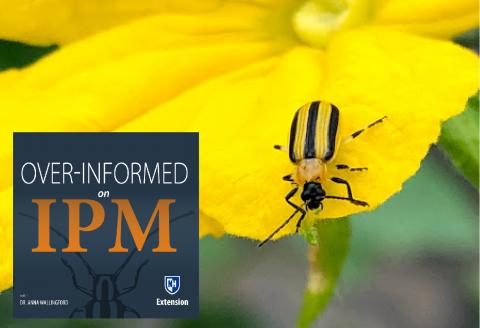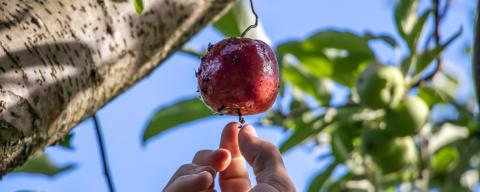Over-informed on IPM - Episode 014: Striped Cucumber Beetle

Show Notes

Even though I have a ton of experience in insect pest management in different parts of the country, I don’t have any experience managing pest insects here in New Hampshire. I’ve been thinking of my first year here at UNH extension as my freshman year. I’ve been talking to as many farmers and extension specialists as I can, getting the lay of the land, understanding the major pest problems in fruits and vegetables, how severe of a problem this thing is or that thing is, when certain species become a problem... The most consistent thing I hear from vegetable growers: striped cucumber beetle. I always say it but, good news for entomologists is usually bad news for growers. While I feel for folks who have to deal with this tough pest species, I’m excited for the opportunity to work with it because we’re currently in kind of a golden age of cucumber beetle research. But I’m getting ahead of myself! First the basics:
From Dr. Eaton’s factsheet: Striped cucumber beetle is one of the most devastating pests of cucurbits east of the Rocky mountains. Adults and larvae feed on crops, the former above ground and the later below ground. Adults are also known to transmit the pathogen responsible for bacterial wilt. This is a common disease in cucurbits, especially cucumbers – if you have wilty plants that are well watered and you can’t find any signs of squash vine borer frass, you might have bacterial wilt. If you break open a stem and find stringy mucus inside, it might be bacterial wilt. Oh – and you’ll love this – although most insect vectors of plant diseases are transmitted from insect spit, this one is probably transmitted via frass. These dirty animals transmit bacterial wilt by pooping where they eat…
Best management practices call for crop rotation and protecting newly planted young cucurbit crops from adults which migrate from elsewhere. Many growers rely on a prophylactive chemical approach by applying a systemic insecticide at planting. Many growers rely on physical controls by using rowcover or will actually handpick these adults. Evening is the best time to handpick if you are into it and – remember that males that found your plants will produce an aggregation pheromone so every male you remove during this invasion period could equal as many as 40 potential cucumber beetles that could be called in by the pheromone. Perimeter trap crops of preferred host – like those big blue hubbard squash – can intercept invading beetles as well.
Overwintered adults that establish on cucurbit crops will mate, lay eggs, and the subsequent larvae migrate below ground to feed on roots. After 2-6 weeks, the next generation of adults emerges. If you weren’t paying attention when the overwintered generation arrived, you’ll definitely notice this emerging generation. Row cover is obviously not an option here as beetles are emerging from the soil. Depending on the species of the crop and the health of plants, there are established thresholds for treatment, somewhere around 4 beetles/plant. However this threshold is much lower if you’re worried about bacterial wilt transmission.
Pesticides must be applied only as directed on the label to be in compliance with the law. Read those labels!
I feel pretty confident that striped cucumber beetle research is a topic we will return to here, but I thought it would be fun to share a conversation I had with a brand new PhD student in Carmen Blubaugh’s lab down in South Carolina. She just finished her master’s degree from the Kuhar lab, which is my home lab – where I got my PhD in Virginia – so we had lots to talk about and she was full of ideas for her PhD project on striped cucumber beetle biology and management.
Haley Bush, Blubaugh Lab at Clemson University
Haley: It’s really fun and interesting to work with Carmen because I’m learning all about the ecological hypotheses and approaches to managing bugs, more tritrophic interactions and predator/prey stuff. I’m pretty excited to get a whole new handle on this IPM thing.
Anna: I have to say I’m a little jealous of Haley because she’s at the really exciting stage of her project where she’s considering going in lots of different directions. One big thing she’s interested in is the interplay between different control strategies in IPM of cucumber beetle, mainly how chemical control affects biological controls, or the natural enemies of the beetles that could do the work of managing a pest population for us. She’s going in a kind of different way than you might expect:
Haley: After digging into the literature I found that, there’s really no natural enemies I can do these tests with so I thought why not work on underground predation? These larvae are definitely more vulnerable than adults. These adults are like little tiny tanks. If you spray them, they’ll evade the sprays. It’s the same with predators. They’re really fast and mobile. Some work has been done with generalist predators aboveground, like spiders, but nothing works very well.
So I wanted to go underground and evaluate the predaceous larvae. It’s going to be a tough objective. I don’t know exactly what I’ll find. I’m guessing generalist carabid larvae, maybe cantharid larvae, I’ve heard that nematodes have been introduced using drip irrigation.
Anna: Haley did mention that there are a few more aboveground natural enemies up her in the northeast, a tachinid parasitoid fly for one. This is a fly that lays its eggs on or near beetles and the larvae that hatch out bore in and parasitize the adult. But it sounds like she’s on to something with underground infestations here as everyone and their brother is investigating entomopathogenic nematodes these days. I’m also looking forward to finding out what happens with the carabids and the cantharids that she’s talking about. These are ground beetles and soldier beetles. The adults are generalist predators and there’s been lots of work from the no-till agriculture world indicating that healthy soils, with lots of organic matter, support lots of these predator beetles, which supports lots of biocontrol. I didn’t even think about what the predator larvae were doing below ground. It’ll take some clever approaches to study this life stage but Haley’s work could make some pretty useful contributions to understanding how cultural management tactics like cover crops and no-till systems could contribute to IPM!
I asked her what else she’s learned about belowground biology in this system while she’s currently deep into her literature review:
Haley: A lot of work in the 80’s and 90’s, actually work was done here at Clemson by Geoff Zehnder, with PGPR, or plant growth promoting rhizobacteria. He found one strain that, if you add it to your soil, it can reduce the amount of cucurbitacin that the plant produces. Cucurbitacin is a feeding stimulant for cucumber beetles and its actually bitter – so it’s supposed to deter herbivores – but since they co-evolved, cucumber beetles love cucurbitacin. This rhizobacteria reduced cucurbitacin so you saw fewer cucumber beetles. But that was back in the 80’s so it’s been a long time since it’s been studied.
I think this approach was dropped when neonicotinoids were introduced to the system as these were seen to control it perfectly, so there’s no more rhizobacteria…
Anna: For the audio record, you rolled your eyes when you said “managed it perfectly”.
Anna: Cucumber beetle behavior is something that holds a lot of potential for non-chemical management strategies, which we will cover in later episodes. I find it very interesting! But its very true that the development of certain insecticidal chemistries play a role in the history of IPM research. Since the 90’s, many commercial producers of these cucurbit crops rely on systemic neonicotinoids, applied at planting, and then they will follow up with regular foliar applications of pyrethroids through the life of the crop. Which brings us back to the theme of the interplay between chemical and biological controls:
Haley: Another objective I have is looking at the downsides to chemical control, specifically looking into secondary pest outbreaks of the melon aphid, which can flare up after the repeated use of pyrethroids.
I want to figure out which pyrethoids cause the most aphid outbreaks and if there’s a threshold to how many sprays cause those outbreaks. If it’s natural enemies being knocked down that’s causing this or – and I don’t want to make any assumption but it might be due to hormoligosis. This is a reproductive stimulation of reproduction when they’re exposed to sublethal doses of insecticide.
Anna: You mean they poop out more babies when they’re exposed?
Haley: They do!
Anna: Is that something that’s been studied?
Haley: It’s been studied in cotton, but I haven’t seen too many papers on melon aphid in cucurbits but…it’s a thing. I’d really like to understand what’s happening here, how to make it better, and if its affecting our predators.
Anna: Hormoligosis! A hard to pronounce word but a good reason to think twice about overusing pyrethroids. It’s counter intuitive but, essentially, what doesn’t kill aphids does makes the population stronger. They respond to the stress of a small dose of neurotoxin by producing more offspring. So the aphid reproduction rate speeds up during a period where natural enemies are gone or – because there will be a lag in reproduction – when natural enemies will be present in a much lower number than would be necessary to control the aphids. Secondary outbreaks obviously don’t happen every time you use pyrethroids but this is a risk with overuse. In my experience, I can’t think of a situation in open culture where aphids have become a serious problem unless there was a broad-spectrum insecticide in the mix. Something to think about and a good reason for the careful use of pesticides, and a good reason for learning more about biological and cultural controls for our key pest species.
So stay tuned for more on how ground cover affects predators (both above and belowground), how predator assemblage affects pest biocontrol, and how chemical and biological control can be used together in an IPM approach to manage this pest. That’s it for now. Thanks to Haley Bush of Clemson University and a special thanks to Brentwood’s favorite son, Jason Lightbown, who wrote and performed our theme music.
post header image by Sadie McCracken, UNH
Related Resource(s)
Complete Show Episode List
Extension Services & Tools That Help NH Farmers Grow
Newsletters: Choose from our many newsletters for production agriculture
Receive Pest Text Alerts - Text UNHIPM to (866) 645-7010
